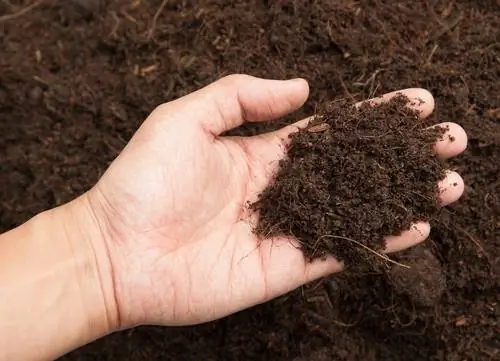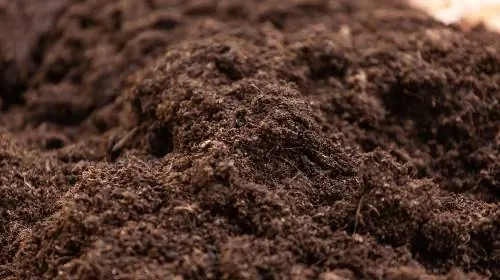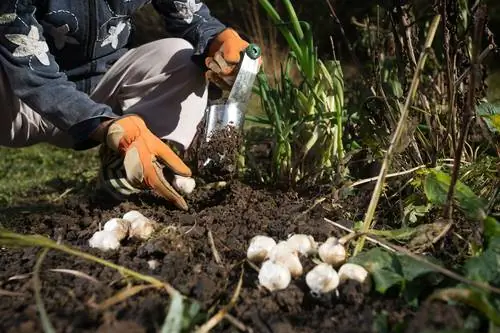- Author admin [email protected].
- Public 2023-12-16 16:46.
- Last modified 2025-01-23 11:22.
Every gardener wants beautifully growing and he althy plants. Essential for this is a good supply of nutrients, which is primarily achieved through soil rich in nutrients. A good humus soil provides your plants with all the important elements. This article will tell you how you can recognize these when buying or even make them yourself.

What is humus soil and what should you pay attention to when buying it?
Humus soil is a mixture of humus and potting soil that ensures good water and nutrient storage and can be used in a variety of ways in the garden. High-quality humus soil should have a 1:1 ratio of humus and potting soil, be peat-free, finely crumbly and smell pleasantly moist.
What is humus?
The word “humus” comes from the Latin language and means something like “earth” or “soil”. In general, dead organic material in its entirety is referred to as humus, with a distinction being made between permanent humus and nutrient humus.
- Nutrient humus: These are quickly broken down substances that serve as food for the organisms living in the soil and ensure better aeration of the soil. Nutrient humus is fundamental for the construction of permanent humus.
- Permanent humus: This is created in the last stage of composting and has the task of binding water and nutrients in the soil. The vast majority of the humus layer in the soil consists of permanent humus.
Gardeners also differentiate between humus forms
- Mull: This is made from easily decomposable materials and serves as a habitat for ground-burrowing insects.
- Rohhumus: This includes vegetation residues that are difficult to decompose, such as litter. They only decompose very slowly into humus.
- Moder: Moder is a mixture of mull and raw humus.
In short, humus is an essential soil component that is created from rotted plant parts.
What is humus soil and where do you get it?
The commercially available humus soil is not pure humus, instead it is potting soil mixed with humus. A good mixture consists of approximately equal parts humus and potting soil. You can buy it in stores everywhere, as humus soil is available from various manufacturers in hardware stores and garden centers, but also at discounters or on the Internet. But be careful when buying: Choose the highest quality branded goods possible, as discounter offers in particular are often made of inferior material. Products containing peat are also not recommended because, on the one hand, they are very critical for ecological reasons and, on the other hand, they do not produce optimal potting soil.
What is humus soil used for?

Humus soil provides a comfortable home for insects
Humus not only stores nutrients and water, but also filters out pollutants from the environment. Humus makes an important contribution to binding and storing carbon and other trace gases. At the same time, humus is a valuable habitat for numerous soil-dwelling animals and microorganisms. Humus soil can be used in a variety of ways in the garden, for example for improving soil, planting new plants, fertilizing existing plantings and repairing damaged lawns. For the latter use, simply spread humus soil in a wide and loose manner on a lawn area in need of repair, distribute it evenly with a rake and then water the lawn. If necessary, you can also reseed it.
Is humus and compost the same thing?
Our word “compost” is derived from the Latin term “compositum”, which means “that which has been put together”. Compost means organic material collected in a heap, which rots with the help of oxygen and soil organisms. This is why the material, which is also very rich in nutrients, is also referred to as “rotting”. At the end of the rotting process, part of the finished compost turns into humus, which makes up the particularly valuable component of this organic fertilizer.
Excursus
Where can you buy good compost?
In the garden, compost soil fulfills similar tasks as humus soil, and both types of substrate are often used synonymously. You can get high-quality compost soil either from your own garden - or from the public composting facilities of the local city or municipal waste disposal company. These are also known as recycling centers. You receive the finished compost loose and at a comparatively low price, but you have to collect it yourself from the responsible recycling center or directly from the composting plant. Make sure to purchase nutrient-rich organic compost, as the green waste compost that is often composted separately is rather poor in nutrients.
How to recognize good humus soil

Good humus soil smells delicious and is finely crumbly and peat-free
You can recognize good humus soil primarily by its smell and its texture. Before you purchase large quantities of a particular brand (and then possibly discover that this humus soil is of poor quality), you should first take a smell and touch sample of a smaller quantity. High quality humus soil
- consists of the ideal mixing ratio of 1:1 humus and potting soil
- is peat-free
- is finely crumbly
- feels light and moist
- has a texture that is pleasant to you
- and smells pleasantly of forest floor
- even a slightly fungal smell is perfectly fine
If, on the other hand, it is fully mature compost soil, there is no noticeable smell. Humus soil of poor quality, however
- feels dry and possibly dusty
- smells unpleasant to putrid
Some industrially produced humus soils only develop an extremely unpleasant smell after the first watering.
Use humus soil correctly
Humus soil can be used in very different ways in the garden and also for potted plants:
- Autumn plantings: Plants planted in the garden in autumn (e.g. many trees) provide you with nutrient-poor humus such as green compost or the commercially available humus bricks. These are often made of coconut fiber. Also apply a potassium fertilizer to improve the plants' frost hardiness.
- Spring plantings: Here you choose nutrient-rich humus, after all, this serves as the start of the growing season. Organic compost is a good choice here, and you can also use other organic fertilizers - such as horn shavings or stable manure - for particularly heavy-consuming plants.
- potted plants: The choice of humus soil depends on the nutrient requirements of the respective plants. Plant heavy-consuming plants in organic compost, while plants with lower nutrient requirements in green compost.
- Soil improvement: Not every soil contains sufficient amounts of humus. Such soils can be improved by adding humus soil. You can do this in both spring and fall. Spread the material generously over the entire floor area and work it superficially into the soil.

In spring, plants need nutrient-rich soil
Excursus
Surface composting for better nutrient supply
Now humus does not last forever, but decomposes over time. So you have to regularly add nutrients to the soil so that the humus formation process continues steadily. So-called surface composting is very suitable for this purpose. To do this, either spread green clippings (e.g. lawn clippings or spinach) as mulch between the plants or sow a harvested bed with green manure plants. You let both rot and then work them into the soil.
Make your own humus soil
For many plants - although not for all - a high humus content in the soil is beneficial. However, in order to significantly increase the humus content of your garden soil, you do not necessarily need to buy expensive humus soil. Instead, improve the soil gradually using the measures shown in the table. However, these are not individual measures, because only as a whole does the soil develop accordingly: soil life increases, as does the nutrient-rich humus layer.
| Method | Materials | When to apply? | What to pay attention to? |
|---|---|---|---|
| Basic fertilization | Garden compost | Spring and if necessary autumn | is not suitable for all plants: be careful with herbs and ericaceous plants |
| Manure fertilization | Stable manure (especially cattle, horses, chickens) | Autumn and also in spring for heavy-feeding plants | only use well-rotted manure, as fresh is too spicy |
| Mulching | organic materials and garden waste (lawn clippings, autumn leaves, etc.) | during the growing season | Mix in horn shavings for low-nitrogen materials (bark mulch, wood chips) |
| Green manure | sow harvested beds with green manure plants | in autumn, undermined in spring | some plants significantly increase the nitrogen content in the soil |
Animals living in the soil such as earthworms are essential for humus formation. You can speed up the process by releasing earthworms in a targeted manner. You can either collect the animals in the wild (just wait for a rain shower) or buy them commercially. You can make humus soil in smaller quantities in a composting container: To do this, mix garden soil with beech leaves and chopped straw and release earthworms into it.
Frequently asked questions
What is Terra Preta and can you make it yourself?
Terra Preta is a type of compost that is mixed with crushed charcoal and is therefore said to be particularly rich in nutrients. The principle comes from South American natives from the Amazon region, who have been fertilizing their gardens in this way for centuries. Now we don't have any rainforest plants here and therefore can't "recreate" the original Terra Preta. However, you can mix your compost with biochar and make this soil more valuable for plant nutrition - charcoal contains many important nutrients in a readily available form.
What is black earth?
Black earth is a particularly humus-rich soil. Basically, the fertility of the garden soil can be recognized by its color: the darker it is, the higher the humus content and the more fertile the soil. However, this is only a rule of thumb, as other factors such as pH are also relevant to this connection. Moorland soil is also very dark, but has an acidic pH value. However, black earth has both the right pH and rich soil life.
Is humus the same as topsoil?
No, humus and topsoil are not the same. Instead, topsoil is the top, fertile layer of earth, which contains a large proportion of humus and other components. Good topsoil also contains minerals in the form of sand, clay, loam or silt, many nutrients (including…a. nitrogen, phosphorus etc.) as well as countless soil organisms.
How deep should the topsoil be?
When planting a new garden, you should add a layer of topsoil about 40 to 60 centimeters thick. This is completely sufficient for the growth of most plants, especially since you can contribute a lot to the constant development of humus in the soil through good soil care. Topsoil is not “static”, but changes and develops over time.
Tip
Many Mediterranean plants do not tolerate humus and grow better on mineral, humus-poor soils. These include herbs such as sage, rosemary or lavender.






